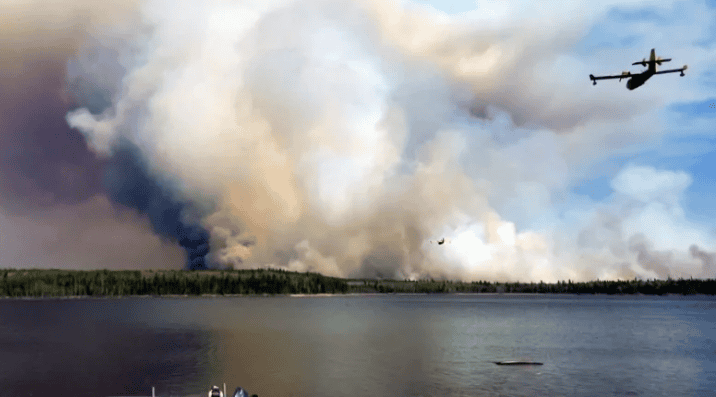Babies and people with respiratory conditions will be flown out first.
Billowing smoke from forest fires has forced community members to flee from two First Nations in southeastern Manitoba.
Evacuations are currently underway in Little Grand Rapids First Nation — and will soon begin in Pauingassi First Nation — for people facing the highest health risks due to smoke from nearby wildfires in Manitoba and northwestern Ontario.
Babies and people with respiratory conditions started flying out of the remote Manitoba community of Little Grand Rapids First Nation on Saturday night, the chief of the community said.
“I’m worried about the smoke, it’s really thick. I have to wear a mask,” Chief Raymond Keeper said.
A spokesperson for Canadian Red Cross said upwards of 200 evacuees will be displaced from their homes in the two First Nations to stay at hotels in Winnipeg.
Little Grand Rapids First Nation
A maximum of 152 evacuees will be flown out of Little Grand Rapids. Of those, 75 are classified as top priority.
The first aircraft into the fly-in community arrived Saturday evening. The First Nation has a shorter airstrip, so evacuations are taking place using a type of Dash plane, which is a smaller aircraft that has space to carry 20 people.
One flight from Little Grand Rapids arrived in Winnipeg last night and two more are en route right now, the Red Cross said.
Names of those under evacuation orders are being announced on the local radio station, Keeper said. According to the federal government, a total of 1193 people live on the reserve.
The community, located about 265 kilometres northeast of Winnipeg, is blanketed by smoke from nearby forest fires. It and many other southeastern Manitoba communities — including Pauingassi — were the subjects of a special Environment Canada air quality statement issued around noon CT Saturday.
“There’s fires all around us, no matter which way the wind is blowing,” said Keeper. “They’re not small fires, either.”
The community, along with another nearby First Nation, was evacuated in May 2018 due to wildfires.
“This time, we’re not taking chances,” Keeper said.
Pauingassi First Nation
Another 50 people could potentially flee from Pauingassi, which is about 280 kilometres north of Winnipeg. That evacuation order went into effect shortly before noon on Sunday.
The federal government’s website indicates the total population on the reserve is 560. Neither remote community has road access.
An email statement from the Manitoba government says the Red Cross is “managing limited precautionary health-related evacuations” on behalf of the First Nation and Indigenous Services Canada, which is the federal department responsible for overseeing Indigenous and Northern Affairs.
“It’s a very challenging time for the evacuees,” a spokesperson for the Red Cross said in an interview.
Evacuation concerns
Red Cross representative Michelle Palansky said evacuees told her they were struggling during mass evacuations from last year’s wildfires, when hundreds of people were forced from fire-threatened communities in Manitoba.
“It was a very stressful situation, really challenging because they’ve left their homes, and they’re unsure about the security of their homes, and they’re in a strange place,” Palansky said.
When they arrive in Winnipeg, evacuees are registered before being assigned and transported to hotel rooms, then arrangements for food and clothing are made. For many, the trip might be their first to the city.
Red Cross helps evacuees get set up during the difficult process. Relief expenses will be paid for by the federal government, Red Cross said in a press release issued Sunday afternoon.
Evacuations from those two isolated communities are expected to be completed today.
In a recent fire update, the province said there were 25 active fires burning across the Manitoba.
It is unknown how long these evacuees will be displaced from their homes.
“It’s going to depend on many things, including the weather,” Palansky said, describing it as a “wait-and-see” situation.

